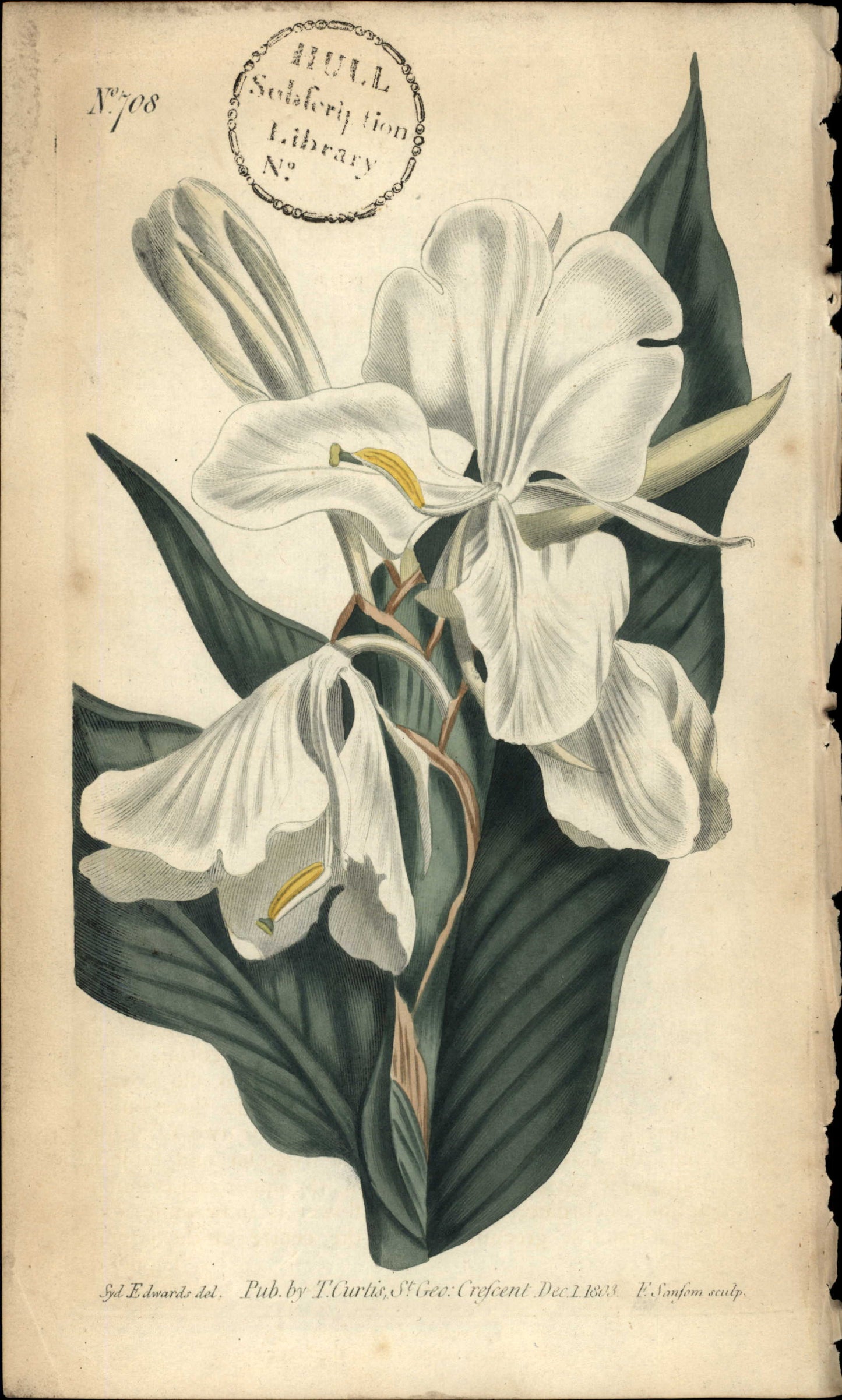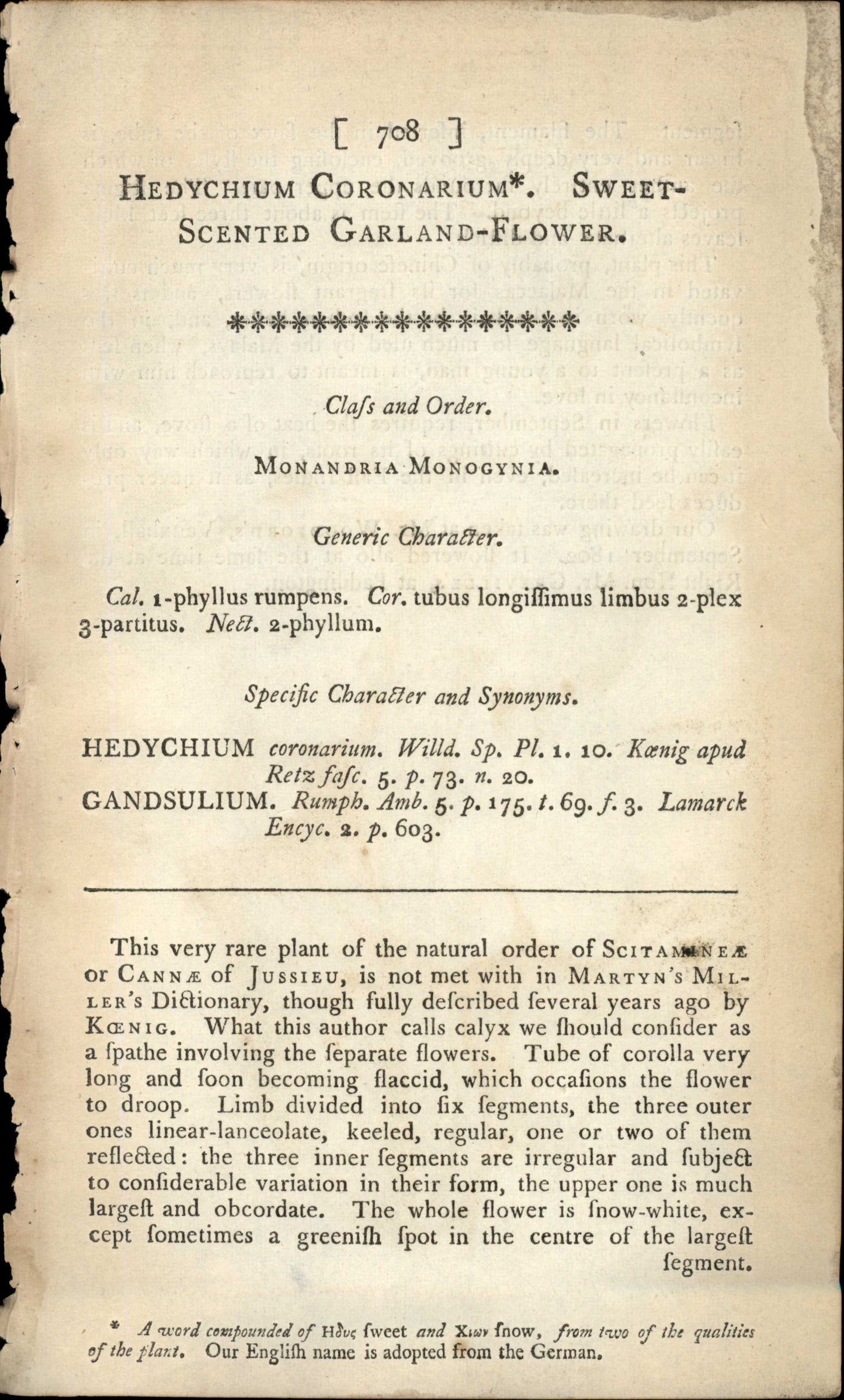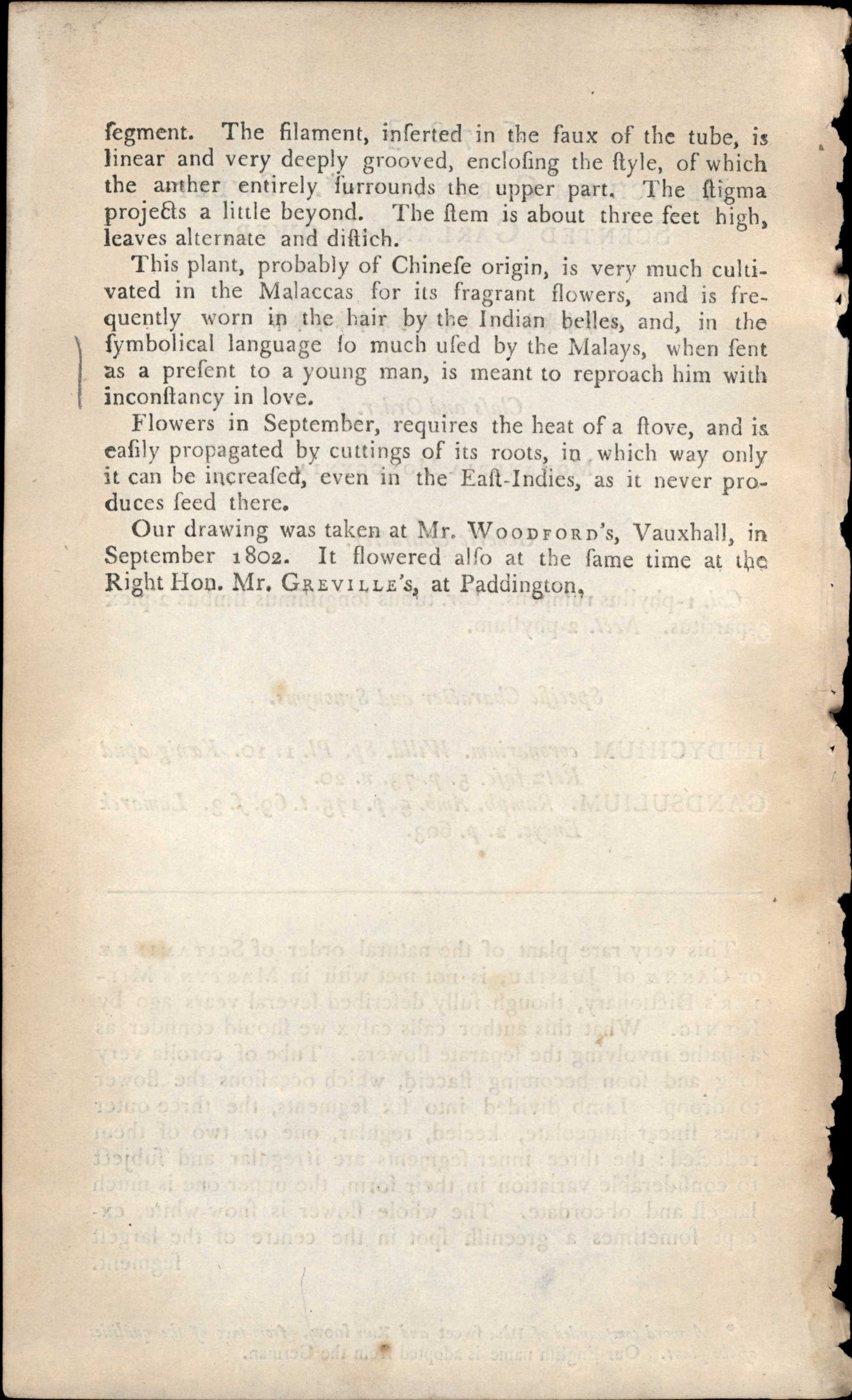Curtis Botanical Magazine
Plate 708 - Monandria Monogynia
Plate 708 - Monandria Monogynia
Couldn't load pickup availability
Plate 708
Flowering Period: September
Publication Date: Dec.1.1803
Description:
Complete Botanical Text (Cleaned)
N708 HULL Solfeription Library N: syd Edwards del, Pub. by TCurtis, sGeo: Crefcent Dec.1.1803 ESanfem sculp [708] Dis 123 HEDYCHIUM CORONARIUM*. sWEET- pdsm Isinil sCENTED GARLAND-FLOWER. 207601 2700 **** ******** Class and Order. thatsz 625 MONANDRIA MONOGYNIA.
Generic Character.
Cal. 1-phyllus rumpens.
Cor. tubus longiffimus limbus 2-plex 3-partitus.
Nect. 2-phyllum. specific Character and synonyms.
HEDYCHIUM coronarium.
Willd. sp.
Pl. 1. 10.
Kanig apud Retz fafc. 5. p. 73. n. 20.
GANDSULIUM.
Rumph.
Amb. 5. p. 175. t. 69. f. 3.
Lamarck Encyc. 2. p. 603.
This very rare plant of the natural order of sCITAMINEE or CANNE of JUsSIEU, is not met with in MARTYN'S MIL- LER'S Dictionary, though fully described several years ago by KOENIG.
What this author calls calyx we should confider as a fpathe involving the separate flowers.
Tube of corolla very long and soon becoming flaccid, which occafions the flower to droop.
Limb divided into six segments, the three outer ones linear-lanceolate, keeled, regular, one or two of them reflected: the three inner segments are irregular and subject to considerable variation in their form, the upper one is much largeft and obcordate.
The whole flower is fnow-white, ex- cept sometimes a greenifh spot in the centre of the largeft segment. * A word compounded of Hdus sweet and Xw fnow, from two of the qualities of the plant.
Our English name is adopted from the German segment.
The filament, inserted in the faux of the tube, is linear and very deeply grooved, enclofing the ftyle, of which the anther entirely furrounds the upper part.
The stigma projects a little beyond.
The stem is about three feet high, leaves alternate and diftich.
This plant, probably of Chinese origin, is very much culti- vated in the Malaccas for its fragrant flowers, and is fre- quently worn in the hair by the Indian belles, and, in the fymbolical language so much ufed by the Malays, when fent as a present to a young man, is meant to reproach him with inconftancy in love.
Flowers in September, requires the heat of a stove, and is easily propagated by cuttings of its roots, in which way only it can be increased, even in the Eaft-Indies, as it never pro- duces seed there.
Our drawing was taken at Mr.
WOODFORD's, Vauxhall, in September 1802.
It flowered also at the same time at the Right Hon.
Mr.
GREVILLE'S, at Paddington,, and- mollydy s AVA abins.c Bad sq Sugo g.or in 1948 MUTHOOTH MUJURAS 800 02 10 7b70 Isusa odi lo insly said T I lo ACTO vd 098 219 letoval bodiolab yllut guod obida an asbrings bicoul ow zino alle sodius aids W .01 yo sijoica to oduT.1wall stage odvlovni sibe Towoll ads 200ilspoo doidw bibos gamood nool bns compel zil oni bebivib di 1, 91010 gain mod to ow) so no lagos bolso for Baidul bus ingenti are amongol asunto not dat no of grein f pail sno : HaBollor dsmobilnce of woll slow a bodo bas flogist flogisk och to one of ni oq dings comin ausigel moods mo borgoba al om go
Raw OCR Text (Original)
N708 HULL Solfeription Library N: syd Edwards del, Pub. by TCurtis, sGeo: Crefcent Dec.1.1803 ESanfem sculp. [708] Dis 123 HEDYCHIUM CORONARIUM*. sWEET- pdsm Isinil sCENTED GARLAND-FLOWER. 207601 2700 **** ******** Class and Order. thatsz 625 MONANDRIA MONOGYNIA. Generic Character. Cal. 1-phyllus rumpens. Cor. tubus longiffimus limbus 2-plex 3-partitus. Nect. 2-phyllum. specific Character and synonyms. HEDYCHIUM coronarium. Willd. sp. Pl. 1. 10. Kanig apud Retz fafc. 5. p. 73. n. 20. GANDSULIUM. Rumph. Amb. 5. p. 175. t. 69. f. 3. Lamarck Encyc. 2. p. 603. This very rare plant of the natural order of sCITAMINEE or CANNE of JUsSIEU, is not met with in MARTYN'S MIL- LER'S Dictionary, though fully described several years ago by KOENIG. What this author calls calyx we should confider as a fpathe involving the separate flowers. Tube of corolla very long and soon becoming flaccid, which occafions the flower to droop. Limb divided into six segments, the three outer ones linear-lanceolate, keeled, regular, one or two of them reflected: the three inner segments are irregular and subject to considerable variation in their form, the upper one is much largeft and obcordate. The whole flower is fnow-white, ex- cept sometimes a greenifh spot in the centre of the largeft segment. * A word compounded of Hdus sweet and Xw fnow, from two of the qualities of the plant. Our English name is adopted from the German. segment. The filament, inserted in the faux of the tube, is linear and very deeply grooved, enclofing the ftyle, of which the anther entirely furrounds the upper part. The stigma projects a little beyond. The stem is about three feet high, leaves alternate and diftich. This plant, probably of Chinese origin, is very much culti- vated in the Malaccas for its fragrant flowers, and is fre- quently worn in the hair by the Indian belles, and, in the fymbolical language so much ufed by the Malays, when fent as a present to a young man, is meant to reproach him with inconftancy in love. Flowers in September, requires the heat of a stove, and is easily propagated by cuttings of its roots, in which way only it can be increased, even in the Eaft-Indies, as it never pro- duces seed there. Our drawing was taken at Mr. WOODFORD's, Vauxhall, in September 1802. It flowered also at the same time at the Right Hon. Mr. GREVILLE'S, at Paddington,, and- mollydy s AVA abins.c Bad sq Sugo g.or in 1948 MUTHOOTH MUJURAS 800 02 10 7b70 Isusa odi lo insly said T I lo ACTO vd 098 219 letoval bodiolab yllut guod obida an asbrings bicoul ow zino alle sodius aids W .01 yo sijoica to oduT.1wall stage odvlovni sibe Towoll ads 200ilspoo doidw bibos gamood nool bns compel zil oni bebivib di 1, 91010 gain mod to ow) so no lagos bolso for Baidul bus ingenti are amongol asunto not dat no of grein f pail sno : HaBollor dsmobilnce of woll slow a bodo bas flogist flogisk och to one of ni oq dings comin ausigel moods mo borgoba al om go
Original botanical print from Curtis's Botanical Magazine
Share







